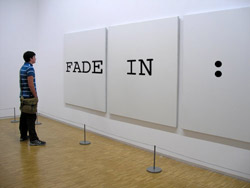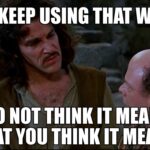Intro
As I mentioned in this post (where I brilliantly announced my blogging return, then promptly disappeared for a month), I thought it would be a good idea to take a look at the craft of some modern scripts that have garnered attention.
Every week or so, I’ll showcase a script that does something really well. The discussion will center on a specific facet of “screenwriting craft.” It won’t be a critique of the full script.
This week’s script is…
Brad Cutter Ruined My Life… Again
Genre: Comedy
Premise: A successful business man is forced to relive his miserable teenage years when the cool kid from his high school is hired at his company. (via IMDB)
Writer: Joe Nussbaum
Details: 112 pages / March 16, 2006 draft
Status: In Development / Black List 2006
Screenwriting craft — What sets this script apart?
CHARACTER THOUGHTS AND EMOTIONS
Somewhere along the line, many screenwriters were scared into believing they should never indicate a character’s thoughts or emotions in scene description. “Only physical actions you can see!”
Obviously, physical manifestations of thoughts and emotions are mainstays of effective screenwriting. But surely, if a character is angry, shocked, embarrassed, etc., we know what that looks like too right? So it’s okay to come up with creative ways to express those thoughts or emotions when appropriate.
Now having said that, determining when it’s appropriate is an art form unto itself. What’s even trickier is coming up with ways to describe a character’s reaction or emotional state with language that’s doesn’t feel bland, and in ways that allow the reader to approach the scene from the point of view of its main character.
Joe Nussbaum is a master at this aspect of modern screenwriting craft.
Check out this script excerpt where the protagonist, Dave, is in a conference room with his boss and coworkers. The set up is that he’s been expecting a promotion to come his way for some time now.
WHITMAN
I have an important announcement to make this afternoon. I’ve worked in this business a long time. I’ve seen a lot of people come and go. Hard workers, creative people, smart businessmen and women. And it takes a lot to impress me.
Dave pumps up. Could Whitman be announcing his promotion right now?
WHITMAN
So when I see a person with that special combination of smarts, skill, charisma and character, I jump at it.
Dave can’t believe this. This is going to be so awesome.
WHITMAN
Every team needs a star player. And I think I’ve found ours.
Dave could burst with excitement.
WHITMAN
He came in to interview last week and I hired him on the spot.
What?
WHITMAN
He’ll be starting on the ground floor, but I have a feeling he’ll work his way up quickly. He arrived a few minutes ago and I sent Cathy to bring him in so you all could meet him right away. Ladies and gentleman...
On cue, Cathy opens the door and brings in...
WHITMAN
Brad Cutter!
Holy shit! Dave gasps. He can’t believe it. Standing next to Whitman is the one and only...
BRAD CUTTER
He looks great. At thirty, he’s handsome, tanned athletic and dripping charisma. Of course he has a full head of hair and hardly an ounce of body fat.
The women are wowed, the men are impressed, and Dave may have just swallowed his tongue.
Notice the way Nussbaum he weaves the physical (e.g. “Dave pumps up.” / “Dave gasps.”) with the internal world of the character (e.g. “Could Whitman be announcing his promotion right now?” / “He can’t believe it.”) You feel like you’re right there with poor Dave.
If memory serves, using a thought reaction as a description (e.g. “What?”) was first pioneered by Oscar-winning scribe Ron Bass. It can be a very effective technique, when used correctly.
Keep In Mind
- Beware “unfilmables” — descriptions that are impossible to see. For example: “Herbert looks up from his meal. Wonders if he should save a piece of lettuce for his pet rabbit, Hoppsie.” How the heck are we supposed to see that on screen?
- In amateur scripts, I commonly see a thought response and a redundant physical response, that doesn’t add any new information, in the same line (e.g. “Huh? Sally looks confused.”)
- I’ve also heard stories of screenwriting contest readers giving negative feedback to correct uses of this technique — just because of their unfamiliarity with it.
- You should also be careful not to interrupt every line of dialogue with description. It’s a big pet peeve of readers. In the scene excerpt above it was used for a very specific comedic effect, and is not representative of the script as a whole.
How about you? Do you utilize thoughts and emotions strategically in your writing?
Further Reading






Like a breath of fresh, his writing rocks.
And yours too. WE WANT MORE POSTINGS.
Good Read Trevor.
Best,
Thanks Andrew. It’s nice to be missed and good to be back (for real this time).